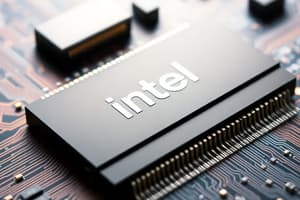Podcast
Questions and Answers
What are the three components of the system bus mentioned in the text?
What are the three components of the system bus mentioned in the text?
- Clock, address, data
- Control, data, clock
- Control, address, data (correct)
- Control, instruction, address
In the simple CPU mentioned in the text, how many address lines are there?
In the simple CPU mentioned in the text, how many address lines are there?
- 8 (correct)
- 16
- 20
- 4
What does the Bus Interface Unit (BIU) in 8088/8086 CPUs do?
What does the Bus Interface Unit (BIU) in 8088/8086 CPUs do?
- Perform arithmetic operations
- Manage memory allocation
- Handle instruction fetching and data transfer (correct)
- Execute instructions
How many bits does the address bus have for the 8088 CPU?
How many bits does the address bus have for the 8088 CPU?
What type of operations does the fetch and execute units in 8088/8086 CPUs perform?
What type of operations does the fetch and execute units in 8088/8086 CPUs perform?
What are the two units that operate in parallel in 8088/8086 CPUs?
What are the two units that operate in parallel in 8088/8086 CPUs?
How many bits is the data bus for the 8088 CPU?
How many bits is the data bus for the 8088 CPU?
What is an essential responsibility of the Bus Interface Unit (BIU) mentioned in the text?
What is an essential responsibility of the Bus Interface Unit (BIU) mentioned in the text?
What does the RSP register address in a microprocessor?
What does the RSP register address in a microprocessor?
Which flag holds the carry after an addition or the borrow after a subtraction?
Which flag holds the carry after an addition or the borrow after a subtraction?
What does the RIP register address in a microprocessor?
What does the RIP register address in a microprocessor?
What does the S (sign) flag hold in a microprocessor?
What does the S (sign) flag hold in a microprocessor?
Which flag indicates whether the result of an arithmetic or logic operation is zero?
Which flag indicates whether the result of an arithmetic or logic operation is zero?
What does the P (parity) flag indicate in a microprocessor?
What does the P (parity) flag indicate in a microprocessor?
What does the A (auxiliary carry) flag hold in a microprocessor?
What does the A (auxiliary carry) flag hold in a microprocessor?
What is the function of the RFLAGS register in a microprocessor?
What is the function of the RFLAGS register in a microprocessor?
What does the TF flag do in 8086?
What does the TF flag do in 8086?
What is the function of the I (interrupt) flag?
What is the function of the I (interrupt) flag?
When the D (direction) flag is set to 1, what happens to the registers?
When the D (direction) flag is set to 1, what happens to the registers?
In what situation does an overflow occur?
In what situation does an overflow occur?
What is the purpose of the IOPL flag in protected mode operation?
What is the purpose of the IOPL flag in protected mode operation?
What does the NT flag indicate in protected mode operation?
What does the NT flag indicate in protected mode operation?
What is the function of the RF flag when used with debugging?
What is the function of the RF flag when used with debugging?
What does the VM flag bit do in a protected mode system?
What does the VM flag bit do in a protected mode system?
Flashcards are hidden until you start studying
Study Notes
System Bus Components
- The three components of the system bus are: data bus, address bus, and control bus
8088 CPU Architecture
- The 8088 CPU has 20 address lines
- The data bus of the 8088 CPU is 8 bits wide
- The address bus of the 8088 CPU has 20 bits
Bus Interface Unit (BIU)
- The BIU retrieves instructions from memory, decodes them, and generates control signals
- An essential responsibility of the BIU is to manage data transfer between the CPU and memory
Fetch and Execute Units
- The fetch unit retrieves instructions from memory and decodes them
- The execute unit executes the instructions
- The fetch and execute units operate in parallel
Registers
- The RIP register holds the address of the next instruction to be executed
- The RSP register holds the address of the top of the stack
- The RFLAGS register contains flags that reflect the result of arithmetic and logical operations
Flags
- The Carry flag (CF) holds the carry after an addition or the borrow after a subtraction
- The Sign flag (S) holds the sign of the result (negative or positive)
- The Zero flag (Z) indicates whether the result of an arithmetic or logical operation is zero
- The Parity flag (P) indicates whether the result has even or odd parity
- The Auxiliary Carry flag (A) holds the carry from the lower nibble to the upper nibble
- The Direction flag (D) controls the direction of string operations
- The Interrupt flag (I) enables or disables interrupts
- The Trap flag (TF) enables single-step mode for debugging
- The Nested Task flag (NT) indicates whether the current task is nested
- The I/O Privilege Level (IOPL) flag determines the I/O privilege level
- The Virtual Mode flag (VM) enables virtual mode operation
- The Resume flag (RF) resumes execution after an exception
Studying That Suits You
Use AI to generate personalized quizzes and flashcards to suit your learning preferences.




